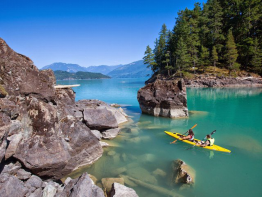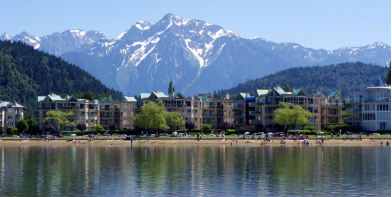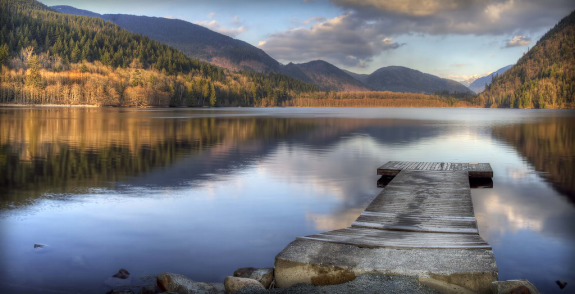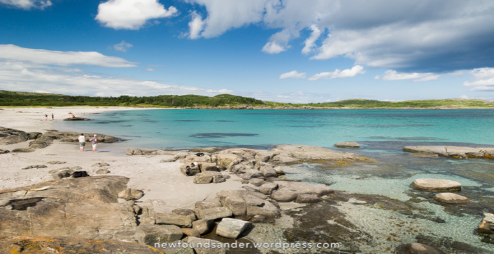Harrison Hot Springs, British Columbia 作者: 来源: 发布时间:2021-03-29
I.Population and Area
₋Area
Land: 5.57 km2 (2.15 sq mi)
₋Population (2016)
Total: 1,468
Density: 263.4/km2 (682/sq mi)

II.Natural Geography

₋The Village of Harrison Hot Springs is a small community at the southern end of Harrison Lake in the Fraser Valley of British Columbia. It is a member of the Fraser Valley Regional District; its immediate neighbour is the District of Kent and included in it, the town of Agassiz. It is a resort community known for its hot springs, and has a population of just over 1500 people. It is named after Benjamin Harrison, a former deputy governor for the Hudson's Bay Company.
₋Megatsunami risk
₋Some geologists consider that an unstable rock face at Mount Breakenridge above the north end of the giant fresh-water fjord of Harrison Lake in the Lower Mainland of southwestern British Columbia, Canada, could collapse into the lake, generating a large wave that might destroy the town of Harrison Hot Springs (located at its south end).
III.ECONOMY
₋Average Harrison Hot Springs Resort and Spa hourly pay ranges from approximately $13.07 per hour for Receptionist to $30.99 per hour for Carpenter.
₋Website: https://ca.indeed.com/cmp/Harrison-Hot-Springs-Resort-and-Spa/salaries
IV.Industrial Characteristics
₋Harrison Hot Springs' major economy is tourism in relation to the hot springs, with over half of employment found in service industries, with much of the rest found split through retail, government, construction and manufacturing are represented, as well as minor activity in other areas.
V.Attractions
1.Sasquatch Provincial Park

₋Sasquatch Provincial Park is a provincial park in Kent, British Columbia, Canada.
₋Located north of Harrison Hot Springs, Sasquatch Provincial Park is characterized by a series of pocket lakes, a unique second-growth and birch forest, and scenic mountain ridges.
₋The park was established 1968, in its present condition. It actually began in 1959 as a 20 hectare inland fjord called Green Point Park, which was expanded into a picnicking area in 1960. Eight years later the park was expanded greatly and renamed. It was named after Sasquatch (a Halkomelem Salish word), the cryptid said to be endemic to the area.
₋Hicks and Deer Lakes are ideal for motor-boating and canoeing, while Trout Lake provides a tranquil fishing experience. Visitors can also enjoy camping, hiking, wildlife viewing, and picnicking.
₋Phone: (604) 986-9371
₋Website: http://bcparks.ca/explore/parkpgs/sasquatch/
2.Harrison Lake

₋Harrison Lake is much longer than it appears when you look at it from Harrison Hot Springs, at 60 kilometers long it covers over 200 square kilometers. While it is now a freshwater lake, thousands of years ago it was not a lake at all, but an arm of the sea. It varies in depth from just a few feet to a maximum depth of 279 m. (916 ft.). It supports a rich bio-diversity of both seasonal and permanent animal species including: Cutthroat trout, Rainbow trout, Dolly Varden, Pink, Chum, Coho, Sockeye, and Chinook Salmon, Sturgeon, Harbor Seals, Canadian Geese, Herons, and too many different types of water fowl to list.
₋A word of warning it is a large, 60 kilometer long, glacier-fed lake and the water can be very cold. As well, storms can make the lake a dangerous place to be, so exercise caution and common sense. To learn more about water safety and Harrison Lake please go to our Water Safety page.
₋The view from the lakefront is dominated by Breckenridge Glacier in the distance and by Echo Island , so called because there is a sensational echo on its western flank. The south end of the lake is very shallow, almost out to the island. Beyond that, the depth drops off to more than 900 feet.
₋Harrison River (18 kilometers) is a short but amazing river. The first designated Salmon Stronghold in Canada, it is the only area in BC to host all five species of salmon and steelhead trout. The salmon habitat in the Harrison Basin is an example of a crucial salmon system that has somehow remained pristine. This abundance of salmon draws in 1000's of Bald Eagles every fall making the Harrison River the 3rd largest gathering place of Bald Eagles in North America.
₋Website: https://www.tourismharrison.com/harrison-lake
3.Sandy Cove

₋Sandy Cove Trail is a 3.5 kilometer moderately trafficked loop trail located near Harrison Hot Springs, British Columbia, Canada that features a lake and is rated as moderate. The trail is primarily used for hiking, walking, nature trips, and bird watching and is accessible year-round.
₋This Harrison Hot Springs hiking trail can be split into two: the hike to Sandy Cove Beach and back, and the full loop. The hike to the beach and back is about 1.2km. The full loop is 4.5km.
₋We've done to full loop in the against-the-clock direction: took us about 4 hours (2:45 pure moving time, as we hang out on the beach a bit).
₋The trail is a bit more difficult than what we've expected of a typical kids-friendly hike – the terrain is quite rough.
₋Website: https://www.alltrails.com/trail/canada/british-columbia/sandy-cove-trail
VI.History
₋The Village of Harrison Hot Springs has been a small resort community since 1886, when the opening of the Canadian Pacific Railway brought the lakeside springs within a short carriage ride of the transcontinental mainline. In its first promotion as a resort it was known as St. Alice's Well, although it had been discovered decades earlier when a party of goldfield-bound travellers on Harrison Lake capsized into what they thought was their doom, only to discover the lake at that spot was not freezing, but warm.
₋Although the resort flourished in a low-key fashion for years after this discovery was exploited by hoteliers, the Village of Harrison Hot Springs was not incorporated until 1949. Its namesake hot springs are a major attraction for tourists who come to stay at the village's spa-resort.
₋The hot springs themselves were originally used and revered by the Sts'Ailes (Chehalis) First Nations people who live along the Harrison River nearby. There are two hot springs, the "Potash", with a temperature of 40 °C, and the "Sulphur", with a temperature of 65 °C. According to Harrison Hot Springs Resort, the waters average 1300 ppm of dissolved mineral solids, one of the highest concentrations of any mineral spring. This hot spring is one of several lining the valley of the Lillooet River and Harrison Lake. The northernmost of the Lillooet River hot springs is at Meager Creek, north of Whistler, with another well-known one to the east of Whistler at Skookumchuck Hot Springs, midway between Pemberton and Port Douglas. One feature of this chain of hot springs is that the Harrison Hot Springs vent is the most sulfuric, and there is consistently less sulfur content as one goes northwards, with the springs at Meager Creek having almost no scent at all.
VII.Other Information
₋Infrastructure
₋Since 2006, the Government of Canada has made unprecedented investments in infrastructure. The Gas Tax Fund provides long-term funding to help every municipality across the country build and revitalize public infrastructure. The Government of Canada has invested over $10 billion to date in municipal infrastructure through this Fund alone, which is now a permanent transfer of $2 billion per year. Between 2006 and 2014, British Columbia will receive more than $1.56 billion from the Gas Tax Fund to improve local infrastructure. The Union of British Columbia Municipalities (UBCM) administers the Gas Tax Fund in British Columbia, in collaboration with Canada and British Columbia.
₋Canada's Economic Action Plan 2013 is delivering a New Building Canada Plan to build roads, bridges, subways, commuter rail, and other public infrastructure in cooperation with provinces, territories, and municipalities. Thanks to the Government of Canada's leadership and our strong economic and financial fundamentals, the Canadian economy has recovered from the global recession better than most other industrialized countries. Canada has been a leader among G-7 countries throughout the recovery with more than 950,000 net new jobs created since July 2009. The New Building Canada Plan, combined with other federal infrastructure investments, supports Canada's infrastructure advantage, a key enabler of economic growth and job creation.
₋Website: https://www.infrastructure.gc.ca/media/news-nouvelles/2013/20130403harrisonhotsprings-eng.html
VIII.Contact Information
₋Government
Mayor: Leo Facio
₋Address:
495 Hot Springs Road
P.O. Box 160
Harrison Hot Springs, BC, V0M 1K0
₋Phone: 604.796.2171
₋Fax: 604.796.2192
₋Website: https://www.harrisonhotsprings.ca/village-office/
